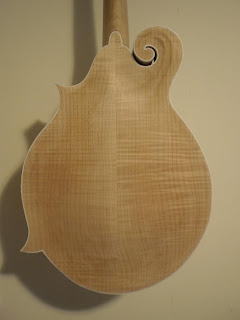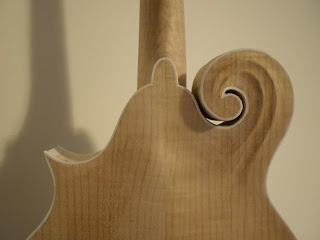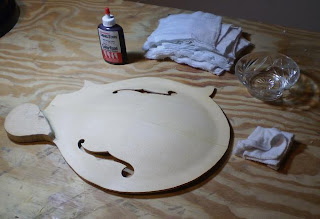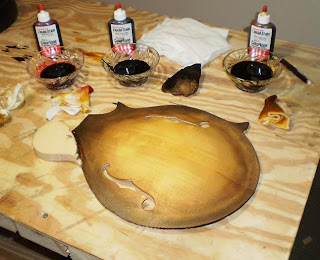Sunday, August 09, 2009
I haven’t been able to spend much time at all on my mandolin for the last couple of weeks, between travel and family time, so that’s why I have been a bit delinquent in updating this blog - but I have gotten some done and hope to get more this week.
I finally managed to get the rest of the binding on the body of the instrument and then get started on binding the peghead.

Because the binding needs to be held tightly while drying, especially for the first couple of hours, I used some wedges of scrap wood on the binding since there doesn’t seem to be a better way to get the job done is such tight quarters.
Here are a couple of shots to show how the back binding came out.


I made my first attempt at staining on the scrap soundboard I prepared earlier for this purpose. To begin I started by rubbing down the entire soundboard with water. I read that when using water-based stain that the dry spruce is bad for soaking up a lot the stain right where it makes contact which makes it difficult to “feather” it if you are attempting to create a sunburst, but by applying the water first, the stain tends to soak in less and give you a chance to feather it. It’s not much to see, but here is my soundboard after applying the water only.

Next, I made another really stupid mistake. I say stupid because there is no excuse what-so-ever for having made it. To create my sunburst, I purchased three different stain colors - Tobacco Brown, Red, and Amber - that are to be used from darkest to lightest from the outside edge to the center. Since I wanted to start at the outside edge and work my way inward, I intended to use the Tobacco Brown to begin. So what I did was I grabbed the Amber (the lightest color) instead of the Brown and rather than actually READING the label, I ASSUMED I grabbed the right bottle. Stupid. Anyway, since I promised to show both the good and the bad, here is how it worked out.

Using a glass cup and a cut-up piece of an old cloth diaper that my wife purchased with a bunch of other material at an auction, I applied the amber stain around the outer edge of the soundboard. As light as it turned out, I assumed I had simply not mixed enough stain with the water, so I added some more stain to the mix and did it again.

Still not dark enough - but not being smart enough to LOOK at the label on the bottle to see what the color was OR what the recommended stain-to-water ratio is, I add even more stain and tried it again.

Better, but not really what I was hoping for, I decided to try mixing some red in to see what that would do. I went to my other two bottles of stain, read their labels, and lo-and-behold, realized I was using the wrong color. Idiot.
By now, the wood was pretty well saturated so I broke out my heat gun and spent some time drying the wood in preparation for staining all over again. Once dried, I mixed up cups of both red and brown and tried it again. Here is how it came out.

I don’t really like the way this came out, but I have yet another scrap soundboard that I will test on again. This time I think I will try it without the hide-glue sealer and after doing a much more thorough job of sanding.
Setting the stain aside, I moved on to cutting the slots into the nut. Opening up and removing the appropriately sized feeler gauge blades from the set my brother-in-law donated, I used my Dremel with a narrow cutting wheel to create my nut saw blades.

For the smallest three slots I was able to locate blades that were either exactly the desired thickness or 0.001” small, but for the largest one, 0.043”, there wasn’t a blade thick enough. For this one, I chose to use two blades, 0.020” and 0.021”, and glue them together with super-glue before cutting the blade slots. I figured that the thin glue layer would be somewhere around 0.002” thick giving me the overall 0.043” thickness I needed.

Turns out that these little saw blades work quite well. They cut the bone pretty easily and holding them in the proper orientation was no problem. I imagine that professionally made blades or files would work just a little bit easier and quicker, but for the price difference ($6.00 vs. $50.00 or more) I really like these guys. I recommend this method to anyone looking to buy or make a set of nut slot saws.
Unfortunately, this is about all I was able to get done in the last couple of weeks. Hopefully I will be able to work on it more this up-coming week.





